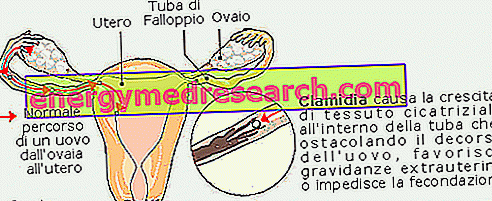Definition
Intertrigo outlines a morbid condition affecting the skin, a consequence of the continuous rubbing between two contiguous body surfaces; in other words, intertrigo is a variant of the classic inflammatory dermatosis, typical of skin folds subjected to friction, especially in those areas where sweat stagnates.
Causes
The sweat that stagnates between two bodily surfaces subjected to continuous friction inevitably generates the slow maceration of the epidermal (surface) layer, an ideal ground for the proliferation of bacteria: it is precisely this condition that lies at the origin of intertrigo. The pathogens most involved in the disease are Candida albicans, Staphylococcus aureus, fungi of the genus Epidermophyton, Streptococcus piogene, Pseudomonas aeruginosa .
- Risk factors: obesity, overweight, poor personal hygiene, sweat stagnation, slightly alkaline stools (in the newborn) that corrode the skin, use of shoes that are too tight
Symptoms
The clinical picture of the intertrigo turns out to be rather complex and quite variable based on the damage caused by the pathogen: the disease begins with redness, de-epithelialization, peeling of the skin, irritation, and itching. Untreated intertrigo can degenerate: intense pain, painful maceration of the skin, erythema, fissures, pustules, bleeding, fissures, blisters.
Information on Intertrigo - Drugs for the Treatment of Intertrigo is not intended to replace the direct relationship between health professional and patient. Always consult your doctor and / or specialist before taking Intertrigo - Intertrigo Care Medications.
drugs
The culture isolation of bacterial colonies is essential before starting a drug treatment: in fact, only after isolating the pathogen responsible for the infection is it possible to proceed with antibiotic therapy. The doctor's opinion is always indispensable: in the case of intertrigo - whose damage is proportional to the delay of the patient in the face of a diagnosis - the immediate medical consultation helps to prevent complications and speed up recovery.
In addition to the administration of antibiotics or antifungals for topical application, intertrigo is also treated with emollient, nourishing and healing creams.
Sometimes, the intertrigo is so severe that the pain becomes unbearable: in this case, the patient can also take pain-relieving drugs or local anesthetics, to lighten the symptoms.
In some cases, topical application of antifungals / antibiotics is not sufficient, therefore further oral therapy is required.
Drugs with topical application for the treatment of intertrigo:
- Miconazole (eg Oravig, Cruex, Micatin): this active ingredient belongs to the pharmacological class of imidazoles, indicated for treating all fungal infections, including intertrigo. The drug works by altering the membrane permeability of mycete cells. Topical application (in the form of powder, cream or spray) is recommended twice a day, on cleansed and thoroughly dried skin. The duration of therapy should be established by the doctor on the basis of the severity of the infection and the response to treatment.
- Clotrimazole, 1% (eg Canesten, Mycelex): in the form of a cream, powder or solution, apply to the infected area twice a day for 10 days. Also this drug, belonging to the class of imidazoles, is indicated to treat intertrigo from Candida albicans .
- Terbinafine hydrochloride (eg Lamisil, Daskil, Lamisilmono): the drug (belonging to the class of allylamines, active against fungi) acts effectively against the fungi belonging to the genus Candida, although the efficacy of the medicine has also been proven for other fungi . Local application of this active substance is also indicated to treat infections in the context of intertrigo. It is advisable to apply the product on the infected skin 1-2 times a day, after having thoroughly cleaned and dried the injured area. After application, it is recommended, especially in the case of intertrigo injuries, to cover the lesion with a bandage, especially during night rest.
Systemic drugs for the treatment of intertrigo:
- Itraconazole (eg Sporanox, Trazer, Itraconaz EG): an excellent drug used in therapy against Candida albicans infections, itraconazole is administered orally in patients with mycotic intertrigo, who do not respond positively to the topical application of specific drugs. It is recommended to take one tablet (200 mg) once a day for one or two weeks, respecting what your doctor has prescribed.
- Fluconazole (eg Diflucan): the drug is indicated for the systemic (oral) treatment of intertrigo sustained by fungal infections. As an indication, take a dose of 150 mg a day for 2 weeks, unless further instructions from the doctor.
- Penicillin (eg. Benzil B, Benzil P): is the antibiotic drug of choice used for the treatment of intertrigo sustained by streptococcus beta hemolytic. In general, the drug should be taken orally for 10 days. The dosage must be carefully determined by the doctor. It is recommended to complete the treatment period with the antibiotic, even when there is a noticeable improvement in symptoms after a few days: completing the drug therapy is one of the preventive measures to avoid infection and antibiotic resistance.
- Amoxicillin (eg Augmentin, Klavux): the antibiotic is indicated to treat interstitial streptococcus pyogenic streptococcus. As an indication, it is recommended to take a dose of drug equal to 250-500 mg orally, three times a day for a period ranging from 1 to 3 weeks, depending on the severity of the condition. Alternatively, it is also possible to take 500-875 mg of the drug twice a day. The dosage just described does not replace the doctor's opinion.
- Amikacin (eg Chemacin, Mikan, Likacin): the drug belongs to the class of aminoglycosides. Indicated to treat Pseudomonas aeruginosa infections in patients with intertrigo. In general, the drug should be taken intramuscularly or intravenously, at a dose ranging from 15 to 22.5 mg / kg per day, divided into 1-3 daily doses, based on the severity of the infection. Do not exceed 1.5 grams per day.
Complementary therapy: "natural" drugs
Even phytotherapy can help lighten the symptoms related to intertrigo: since the disease is characterized by the desquamation and the swelling of the anatomical site in which it occurs, the application of nourishing, healing and skin restoring creams is very useful for enhance the action of the drug, although it cannot clearly constitute an alternative to drug therapy.
Below are some of the plants used in therapy for the formulation of creams, ointments or ointments aimed at rehabilitating intertrigo.
- Aloe vera ( Aloe vera gel ): particularly suitable for its restorative and refreshed properties. The extract contains organic acids, vitamins and polysaccharides indicated to promote wound healing
- Hypericum oil ( Hypericum perforatum ): the phytocomplex is used in therapy for the treatment of intertrigo, thanks to its antiseptic, healing and re-epithelizing properties.
- Grapefruit seeds (of the Citrus plant × paradisi ): rich in flavonoids, the extract of grapefruit seeds is used in natural therapy parallel to the intertrigo due to the antiseptic properties, therefore disinfectants, which are suitable to remove bacteria and fungi that colonize the sores formed by intertrigo.
The drugs described above are just some of the many "drugs" that nature offers for the treatment of intertrigo; to remember that the sores that accompany the disorder can be lightened also through the application of talchi, based on zinc oxide, oats and corn starch, which act as soothing, astringent and anti-itching.
In the case of obesity or overweight, it is recommended to follow a hypocaloric diet aimed at reducing the weight which, as we have analyzed, when it is high constitutes one of the risk factors for the appearance of intertrigo.



